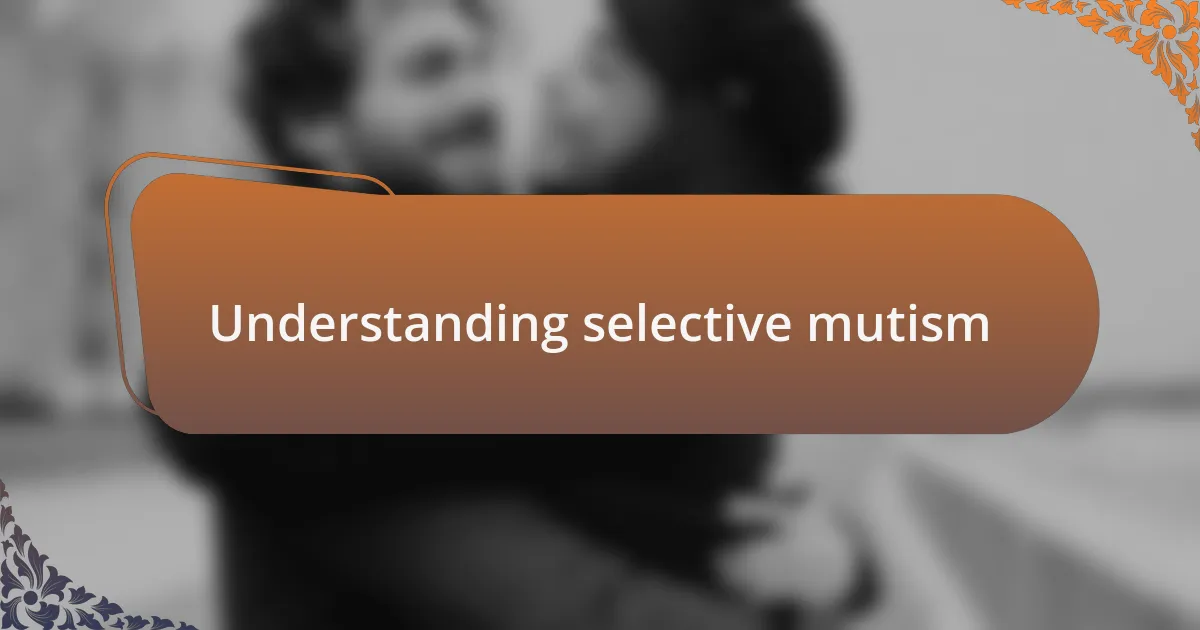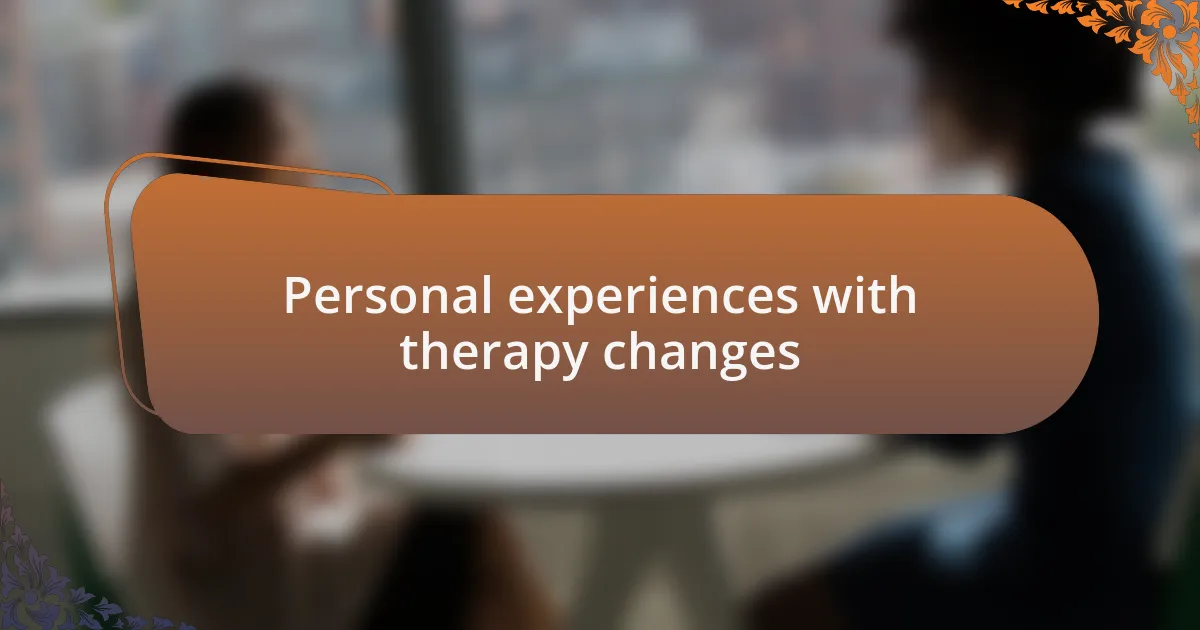Key takeaways:
- Selective mutism is an anxiety disorder where children can speak comfortably at home but struggle in social settings, stemming from profound fear rather than mere shyness.
- Research is essential for developing effective therapeutic strategies, as evidenced by the application of gradual exposure techniques that showed significant progress in children with selective mutism.
- Case studies highlight the effectiveness of varied therapies, such as cognitive-behavioral therapy and play therapy, showing how family involvement and creative expression can facilitate communication in children.
- Personal experiences with alternative therapeutic methods, like storytelling and sensory integration techniques, reveal transformative ways to manage emotions and improve communication skills.

Understanding selective mutism
Selective mutism is a complex anxiety disorder primarily seen in children, where they struggle to speak in certain social situations despite being able to communicate comfortably in others, like at home. I remember one time when a young girl, whom I’d met during my volunteer work, remained silent in class but would burst into laughter and chatty exchanges with her parents. This stark contrast opened my eyes to the unseen barriers children face and made me wonder: how often do we overlook their internal struggles?
Understanding selective mutism requires recognizing its roots in anxiety; it’s not simply shyness but a profound fear that can be paralyzing. I recall discussing this with a parent whose child was silently suffering in the classroom. She expressed her frustration, and I could feel the weight of her concern. It made me question how many teachers understand that silence doesn’t equate to a lack of thoughts or ideas.
This condition often coexists with other anxiety disorders, further complicating the emotional landscape. In my experience talking with families, many were surprised to learn that selective mutism is not just about the inability to speak but also about intense feelings of fear and a desire to connect. It’s a reminder that behind every silent child lies a world of emotion and potential waiting for understanding and support.

Importance of research in therapy
Research in therapy serves as a crucial cornerstone, shaping how we understand and approach cases like selective mutism. I still vividly remember attending a workshop where a therapist shared findings from recent studies that illuminated the neural pathways involved in anxiety. It was eye-opening to see how empirical data could translate into actionable strategies for helping children who remain silent in social settings.
The impact of research isn’t just theoretical; it can directly influence therapeutic practices. For instance, after reading a comprehensive study on the effectiveness of gradual exposure techniques with children, I applied these methods in my sessions. The progress I witnessed was remarkable; one child who had barely whispered in my office slowly began to express himself more readily. It made me wonder—how many other effective strategies remain untapped simply because we haven’t looked closely enough at the evidence?
Understanding the importance of research also encourages us to dispel myths that can hinder progress. During discussions with educators about selective mutism, I realized how critical it was to back up our insights with data. When I presented statistics showing the high correlation between selective mutism and social anxiety, I noticed a shift in their attitudes. They began to consider the importance of providing supportive environments for our silent students, demonstrating just how transformative research can be in fostering empathy and awareness.

Case studies on effective therapies
When I dove into case studies focusing on selective mutism therapies, one that stood out to me described a child who thrived using cognitive-behavioral therapy (CBT) combined with parent training. The parents learned to create a comfortably controlled environment, gradually introducing social situations. It was heartwarming to see the family dynamic fostered a sense of safety, allowing the child to step out of her shell. Isn’t it fascinating how involving the family can create such a profound shift?
Another case study illustrated the use of play therapy, emphasizing how spontaneous interactions can pave the way for communication. I read about a therapist who introduced playful activities like puppetry and storytelling, which transformed the child’s reluctance into eagerness to express. Witnessing the child connect through play made me reflect: What if we prioritized play more in our therapeutic settings? These examples demonstrate just how versatile therapy can be when tailored to fit individual needs.
One particularly moving case involved a young boy who began to speak through a tailored art therapy program. As he expressed himself through drawings, he found his voice alongside his creations. After attending a session where the therapist focused entirely on understanding his artwork, I couldn’t help but feel a deep connection to this approach. Could it be that creativity unlocks the door that traditional methods sometimes miss? These stories remind me that therapy is not just about speaking; it’s about finding ways to communicate that resonate with each unique child.

Personal experiences with therapy changes
When I first encountered changes in my therapy approach, I was both nervous and hopeful. I remember a session where my therapist introduced a more experiential method, encouraging me to explore my feelings through guided mindfulness activities. At that moment, I understood the power of just being present; it was like lifting a weight I didn’t even know I was carrying. Have you ever felt such an unexpected release?
Transitioning from traditional talk therapy to a more creative outlet was eye-opening for me. I vividly recall a specific session where we incorporated art into our discussions. Instead of merely explaining my emotions verbally, I found solace in painting them. It wasn’t just a creative exercise; it felt liberating, as if I were discovering a new language. How amazing it was to express what I couldn’t put into words!
One memorable instance was when my therapist invited me to engage in role-play scenarios, a method I’d initially dismissed as silly. However, it opened my eyes to perspectives I hadn’t considered before. Each role we acted out brought dimensions to my understanding of social situations, showing me that stepping outside of my comfort zone often held the key to my growth. Have you experienced a breakthrough through an unexpected approach?

Techniques I adopted from research
One technique that really resonated with me was the use of storytelling to process my emotions. During one session, my therapist encouraged me to write a short story about a character who faced challenges similar to mine. I discovered that shaping my experiences into a narrative made them more manageable, almost like creating a safe space where I could explore difficult feelings without fear. Have you ever tried to voice your struggles through a story?
Incorporating breathing exercises into my routine was another powerful shift I adopted. I remember a particularly overwhelming moment when my anxieties felt insurmountable. My therapist guided me through deep, rhythmic breathing, and I felt a tangible shift in my body’s tension. It was as if I had discovered a switch to calm my racing thoughts. How often do we forget the power of simply breathing?
One surprising technique emerged from recent research on sensory integration. I began to use tactile tools, like stress balls and textured fidget items, during sessions. Initially, it seemed trivial, but these small objects anchored my attention and helped channel my nervous energy. As I squeezed the stress ball, I felt my worries melting away, allowing me to focus on the conversation. Can you see how small changes can lead to great insights?